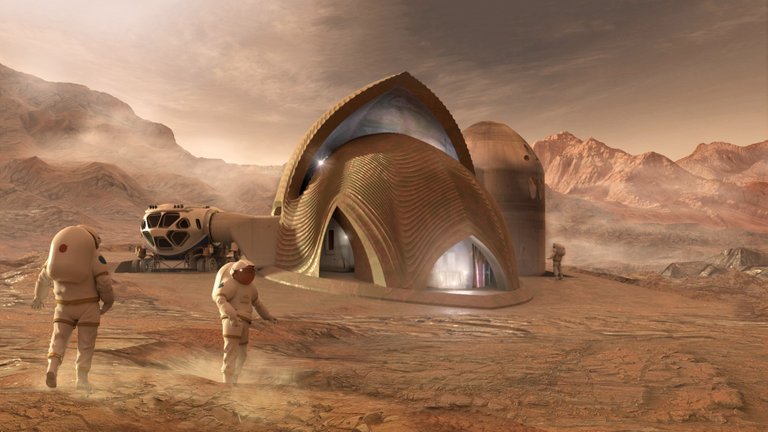
Source
We have already commented more than once in this blog on the irreversible decision to make humanity a multi-planetary species and since Mars, being the closest planet that can be colonized, has been chosen as the first outer planet to be colonized, but this is much easier said than done and presents great challenges.
Ya hemos comentado más de un vez en este blog la irreversible decisión de hacer de la humanidad una especie multi-planetaria y como Marte, al ser el planeta más cercano susceptible de se colonizado, ha sido elegido como el primer planeta exterior a colonizar, pero esto es mucho más fácil de decir que de hacer y presenta grandes retos.
Assuming that we are capable of overcoming the challenge of traveling more than 50 million kilometers that separate us from Mars in its most favorable position, with a manned spaceship and keeping the crew alive, feeding and entertaining them during the more than six months that it will last the trip without incident, we still need to condition Mars for life.
Suponiendo que seamos capaces de superar el reto de recorrer más de 50 millones de kilómetros que nos separan de Marte en su posición más favorable, con una nave tripulada y mantener con vida, alimentando y entreteniendo a sus tripulantes durante los más de seis meses que durará el viaje sin incidencias, aún necesitamos acondicionar Marte para la vida.

Source
Among other enormous challenges such as water, oxygen or building some type of housing for future settlers, it will also be necessary to find solutions to manufacture tools or spare parts necessary for rockets in situ with materials and resources that we can find on the planet Mars, since sending these from Earth is unfeasible.
Entre otros enormes retos como el agua, el oxígeno o construir algún tipo de viviendas para los futuros colonos, también se necesitará buscar soluciones para fabricar herramientas o repuestos necesarios para los cohetes in situ con materiales y recursos que podamos encontrar en el planeta Marte, pues resulta inviable el envío de éstos desde la Tierra.
That is why it is good news that a group of researchers from the School of Mechanical and Materials Engineering at Washington State University have managed to make a very resistant material by mixing a small amount of crushed Martian rock with a titanium alloy, material that could be used in a 3D printing process to manufacture all kinds of tools and spare parts.
Por eso es una buena noticia la protagonizada por un grupo de investigadores de la Escuela de Ingeniería Mecánica y de Materiales de la Universidad Estatal de Washington que han conseguido fabricar un material muy resistente mezclando una pequeña cantidad de roca marciana triturada con una aleación de titanio, material que se podría usar en un proceso de impresión 3D fabricar todo tipo de herramientas y repuestos.

Source
For this study, the researchers used a powder-based 3D printer, mixed simulated Martian rock powder with an alloy of titanium, a very strong and heat-resistant metal, which was then heated with a high-power laser to more than 2,000 ºC, then the molten mixture was poured into molds with different sizes and shapes.
Para este estudio, los investigadores utilizaron una impresora 3D basada en polvo, mezclaron el polvo de roca marciana simulado con una aleación de titanio, un metal muy fuerte y resistente al calor, que fue posteriormente calentada con un láser de alta potencia a más de 2.000ºC, a continuación, la mezcla fundida se vertió en moldes con diferentes tamaños y formas.
Once the material cooled, the researchers found that it had great strength and durability.
All this of course has been done under laboratory conditions and with simulated Martian regolith, since we have very little real Martian regolith to do experiments with, but we are one step closer.
Una vez enfriado el material, los investigadores comprobaron que tenía gran resistencia y durabilidad.
Todo esto por supuesto ha sido realizado en condiciones de laboratorio y con regolito marciano simulado, pues tenemos muy poco regolito marciano real para hacer experimentos, pero ya estamos un paso más cerca.
More information/Más información
https://makezine.com/article/science/space/the-martian-bases-of-the-future-may-be-made-from-regolith-and-water-ice/
Hola @mauromar, lo bueno es que ya tienen bastante material cuando lleguen allá.

😉👍 sounds like a good step forward! :)